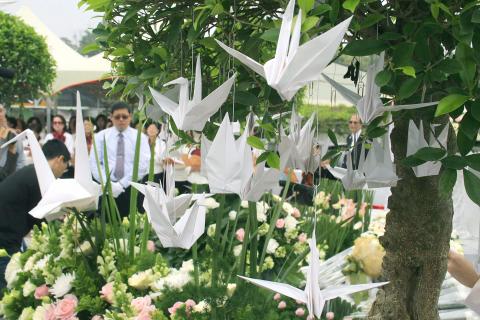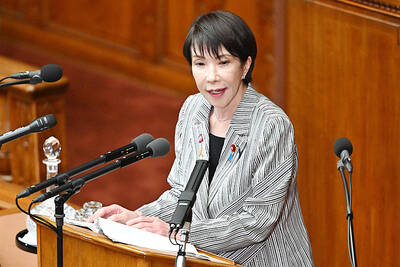The government is obligated to uncover the truth behind the 228 Massacre and relieve the pain of victims’ families, President Ma Ying-jeou (馬英九) said yesterday, dismissing comments by former premier Hau Pei-tsun (郝柏村) earlier this week that cast doubt on the number of people killed in the incident.
Ma, attending an exhibition in Taipei in memory of members of the judiciary killed in the massacre, acknowledged the then-Chinese Nationalist Party (KMT) regime’s poor handling of the incident and said his administration would continue efforts to uncover the historical truth, learn lessons and avoid making the same mistakes.
“The focus is not on the number of the people that were killed ... The then-government mishandled the incident and of course the government is responsible for the consequences,” he said at Taipei’s 228 Memorial Museum.

Photo: CNA
The president’s remarks came amid a recent dispute over Hau’s comments that only about 500 people — instead of the commonly seen estimates of about 30,000 — were killed during the massacre.
In a Chinese-language op-ed piece published in the United Daily News on Tuesday, Hau challenged the content of a history textbook which states that more than 10,000 people were killed during the 228 Massacre and said that in his view, only a little more than 500 people were killed in the crackdown.
The 228 Massacre refers to a nationwide uprising against the KMT regime that broke out on Feb. 27, 1947, two years after the KMT took over Taiwan, because of government corruption and economic hardships.
The op-ed drew a strong reaction from victims’ families, who criticized Hau for what they said were distortions of the truth.
Ma, who has emphasized his efforts to uncover the truths about the incident, dismissed Hau’s comments for the first time yesterday.
Family members of the victims who attended the exhibition yesterday also condemned Hau, urging him not to rub salt into their wounds.
“The actual number of victims is not the most important issue here, but no one should take advantage of the massacre,” said Wang Ke-shao (王克紹), whose father was taken by the KMT during the incident, never to return home.
“The number of people who were killed in the incident is clearly stated, it was between 18,000 and 28,000,” he said.
Wang said his father, the first Taiwanese to serve as a prosecutor in Japan, was taken away by the KMT on March 14, 1947, for reasons that were never disclosed.
While agreeing with the government that the massacre was not a confrontation between ethnic groups, he demanded that government documents be released and that an archive be established that is accessible to families of the victims.
“At least let me know when my father died, where he died and what the crimes he was accused of were,” he said.
Attending the exhibition, Taipei Mayor Hau Lung-bin (郝龍斌), the son of Hau Pei-tsun, declined to comment on his father’s controversial remarks while insisting that the government should be devoted to uncovering the truth.
“The truths of the 228 Massacre should be uncovered and we should learn the lessons. More importantly, we must be sympathetic about the hardship and the pain of the victims’ families,” he said.
The 228 exhibition displays manuscripts and artifacts from members of the judiciary who were killed in the uprising.
The exhibition reminds the government of the serious consequences of incorrect policy decisions and it helps memorialize the spirits of the dead, said Hau Lung-bin, who organized the event.
The exhibition at the 228 Memorial Museum runs until June 3.
Additional reporting by CNA

The Central Weather Administration (CWA) yesterday said it expected to issue a sea warning for Typhoon Fung-Wong tomorrow, which it said would possibly make landfall near central Taiwan. As of 2am yesterday, Fung-Wong was about 1,760km southeast of Oluanpi (鵝鑾鼻), Taiwan’s southernmost point, moving west-northwest at 26kph. It is forecast to reach Luzon in the northern Philippines by tomorrow, the CWA said. After entering the South China Sea, Typhoon Fung-Wong is likely to turn northward toward Taiwan, CWA forecaster Chang Chun-yao (張峻堯) said, adding that it would likely make landfall near central Taiwan. The CWA expects to issue a land

Taiwan’s exports soared to an all-time high of US$61.8 billion last month, surging 49.7 percent from a year earlier, as the global frenzy for artificial intelligence (AI) applications and new consumer electronics powered shipments of high-tech goods, the Ministry of Finance said yesterday. It was the first time exports had exceeded the US$60 billion mark, fueled by the global boom in AI development that has significantly boosted Taiwanese companies across the international supply chain, Department of Statistics Director-General Beatrice Tsai (蔡美娜) told a media briefing. “There is a consensus among major AI players that the upcycle is still in its early stage,”

The Central Weather Administration (CWA) yesterday said it is expected to issue a sea warning for Typhoon Fung-wong this afternoon and a land warning tomorrow. As of 1pm, the storm was about 1,070km southeast of Oluanpi (鵝鑾鼻), Taiwan’s southernmost point, and was moving west-northwest at 28 to 32kph, according to CWA data. The storm had a radius of 250km, with maximum sustained winds of 173kph and gusts reaching 209kph, the CWA added. The storm is forecast to pass near Luzon in the Philippines before entering the South China Sea and potentially turning northward toward Taiwan, the CWA said. CWA forecaster Chang Chun-yao (張峻堯) said

Japanese Prime Minister Sanae Takaichi yesterday said that China using armed force against Taiwan could constitute a "survival-threatening situation" for Japan, allowing the country to mobilize the Japanese armed forces under its security laws. Takaichi made the remarks during a parliamentary session while responding to a question about whether a "Taiwan contingency" involving a Chinese naval blockade would qualify as a "survival-threatening situation" for Japan, according to a report by Japan’s Asahi Shimbun. "If warships are used and other armed actions are involved, I believe this could constitute a survival-threatening situation," Takaichi was quoted as saying in the report. Under Japan’s security legislation,